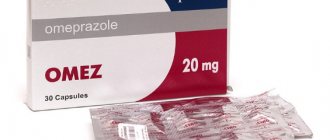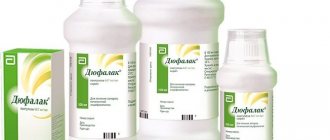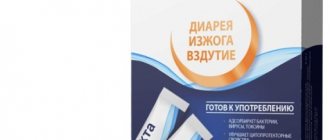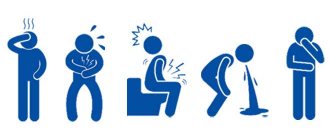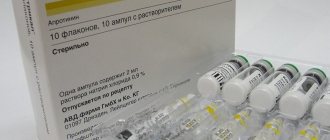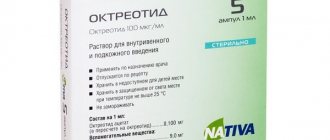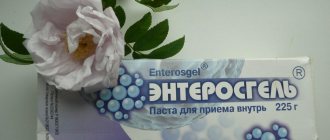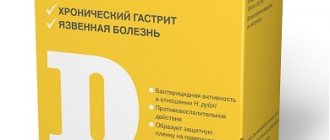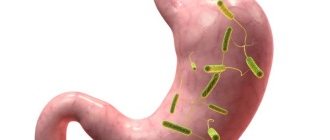For gastric ulcers, the complex of therapy includes drugs that accelerate the healing process of the affected mucosa, antibiotics, antacids and histamine receptor blockers. Medicines with regenerating properties are preferably used in the form of injections. Medicines that accelerate the restoration of damaged tissues occupy a central place in the treatment of gastric ulcers, increasing the effect of the entire complex. The drug Solcoseryl for stomach ulcers is used to restore trophism and stimulate scarring of erosions on the walls of the stomach. The product is produced in several dosage forms: gel, ointment, dragees, paste, ampoules. In the complex treatment of stomach ulcers, only the ampoule form is used.
The use of the injection form of Solcoseryl for ulcers
Peptic ulcers of the stomach and duodenum are characterized by the formation of lesions on the mucous membrane of varying sizes and depths. Due to poor supply of oxygen and necessary substances, hypoxia occurs, tissues lose the ability to recover on their own, and there is a risk of cell death without subsequent opportunity to restore them. Without treatment, stomach and duodenal ulcers can result in perforation and death. Stimulation of self-healing and scarring processes is an important part of the complex of therapy for peptic ulcer disease. The faster the erosive changes begin to scar, the faster the patient will return to normal life.
Pharmacological properties of the drug and effectiveness in pathology
The composition of the drug Solcoseryl includes purified blood of young calves, which has a powerful biogenic effect, enhances the effect of basic medications for the treatment of ulcerative lesions of the stomach and intestines. The therapeutic effect consists of the following effects:
- improving blood supply to tissues in the area of mucosal lesions;
- increased regeneration of lining epithelial cells;
- saturating cells with oxygen, accelerating glucose utilization;
- increased collagen synthesis due to increased phosphorus metabolism;
- increased energy in cells and increased intercellular substance in the lining of the stomach or intestines.
There are no exact data on the rate of absorption, excretion and time of distribution in the tissues of internal organs. When prescribing, they are guided by the severity of the disease, concomitant therapy, and the risks of complications.
Properties of the injection form of Solcoseryl
The drug is produced from the blood of young calves by deproteinization (protein separation). In its cell mass it contains low molecular size amino acids, oligopeptides, microelements, and electrolytes. Solcoseryl restores nutrition and oxygen supply to organs and tissues, starts the process of formation of collagen fibers, regeneration and self-healing. Thanks to improved oxygen and glucose saturation, cell energy increases, the number of amino acids increases, and adenosine triphosphoric acid is rapidly broken down. Pharmaceutical factories have not invented synthetic analogues of Solcoseryl. A similar ampoule form for the active component is Actovegin.
Solcoseryl for peptic ulcers is prescribed not only to accelerate the healing of damaged mucosa, but also to prevent necrosis in inflamed areas during hypoxia of internal organs. During the course, toxic compounds are eliminated, liver function improves, the functioning of other organs improves, well-being returns to normal, appetite and good sleep return.
Solcoseryl has a direct effect on the digestive organs:
- new epithelial cells occur;
- enzymes responsible for redox reactions in the intestines are activated;
- vascular circulation improves.
The drug does not pass through the excretory system and is completely absorbed by the body; this is due to its natural origin and the similarity of cells to human cells.
According to the instructions for use, the use of Solcoseryl for stomach ulcers does not cause addiction or withdrawal symptoms. No cases of overdose have been reported.
After 4-7 days from the start of therapy, symptoms typical for peptic ulcer disease disappear:
- nausea;
- pain in the epigastric region;
- belching;
- increased salivation;
- heartburn.
The injection form of Solcoseryl is the first choice for the treatment of erosive changes in the mucous membrane of the gastrointestinal tract in the following groups of patients:
- in the elderly;
- for diabetes;
- in hypertensive patients;
- with coronary heart disease.
According to the instructions for use, Solcoseryl in injections for stomach ulcers does not have a sedative effect, drowsiness, or decreased attention, so it is possible to drive a car during treatment.
Solcoseryl ointment. What does the drug help with, medicinal properties. Instructions for use
Solcoseryl ointment is used to accelerate the healing of wounds, burns, frostbite, bedsores, trophic ulcers in varicose veins. Initially, for an open or weeping wound, a gel is prescribed for drying, and when healing begins, they switch to ointment.
The drug can also be used in gynecological practice (erosion, sutures after cesarean section), proctology (external hemorrhoids), and for fissures. For chronic ulcers or extensive wounds, the ointment is combined with intravenous injections.
Contraindications: intolerance, presence of pus and destroyed tissue before surgical treatment.
Solcoseryl rarely causes adverse reactions even with long-term treatment. If redness, swelling and burning appear and there is no result within 2 weeks, you should consult a doctor.
Main characteristics of Solcoseryl ointment
Solcoseryl ointment is a medicine for external use, has a wound-healing effect, improves metabolic processes in the skin. This is not a hormonal drug, its mechanism of action has not been fully studied, but its healing properties have been proven for various skin lesions. The main characteristics of Solcoseryl ointment and gel are given in the table.
| Sign | Solcoseryl ointment | Solcoseryl gel |
| Group of drugs | Improving trophism (nutrition), regeneration (restoration) of tissues | |
| Manufacturer | Meda Pharma, Switzerland | |
| Active substance | Deproteinized (deprived of protein) dialysate (purified on a dialysis machine) of calf blood | |
| Active ingredient concentration | 2.06 mg per 1 g | 4.1 mg per 1 g |
| Auxiliary Ingredients | Benzoic acid derivatives, alcohol, cholesterol, petroleum jelly, water | Benzoic acid derivatives, propylene glycol, pentahydrate, water |
| Appearance | Fatty mass, white or yellowish in color, smells of Vaseline, meat broth | No color, transparent, dense in consistency, with the smell of meat broth |
| Storage conditions | At room temperature no higher than 30 degrees, and after opening no more than 28 days at 15-25 degrees | |
| Best before date | 5 years | |
| Release from pharmacy | Over the counter |
What is Solcoseryl, other forms of the drug
Solcoseryl is a Swiss brand that produces a number of drugs with the same name: ampoules for intravenous administration, ointment and gel. There are also special forms - eye gel and dental paste. Cream and dragees from calf blood extract can be purchased in the form of an analogue in composition - Actovegin.
Composition of the drug
Solcoseryl contains an extract from the blood of dairy calves. It is obtained by passing through a filtration system (dialysis with ultrafiltration). The result is serum devoid of proteins and small parts of cells. They are presented:
- carbohydrates,
- fats,
- nucleic acids,
- particles of cell nuclei,
- amino acids,
- microelements,
- intermediate exchange connections.
Purifying the blood from protein reduces its ability to cause allergic reactions and increase temperature, that is, the result is a non-antigenic and pyrogen-free serum.
We recommend reading about the most effective ointments for scars. From the article you will learn about how ointment for scars works, the best ointments for the face, body, after surgery and new generation ointments. And here is more information about how Panthenol helps and what it is used for.
Pharmacodynamics
Low molecular weight substances in Solcoseryl exhibit medicinal properties:
- support metabolic reactions - increase the consumption of oxygen, glucose, accelerate oxidation reactions;
- stimulate energy production, especially in cells with low blood supply;
- improve the healing of wounds and other skin lesions;
- restore the viability of cells suffering from lack of nutrition;
- prevent the spread of tissue destruction;
- help the formation of new collagen fibers in the skin (they give strength and elasticity);
- activate cell division.
As a result, the skin that is damaged or experiencing nutritional deficiency restores its structure, and healing of defects and wound surfaces occurs.
Pharmacokinetics
Since the active substance Solcoseryl (deproteinized hemoderivative) contains a mixture of a variety of molecules that differ in physical and chemical properties, their absorption and distribution are not yet possible to study.
Therefore, many of the effects of the drug remain unexplored, and its use is largely empirical, that is, based on previous experience: it is known that the drug works, but exactly how it works is not clear. It has only been established that the ointment and gel practically do not penetrate the bloodstream, their effects are limited to the skin.
Anti-wrinkle action
It is noteworthy that the product (ointment) began to be used in cosmetology to get rid of wrinkles, since cells regenerate and renew themselves faster, which has a beneficial effect on appearance.
Hemodialysate (extract from the blood of calves):
- Improves blood circulation.
- Normalizes pH levels.
- Accelerates metabolism at the cellular level.
Vaseline, which is part of the ointment, softens and nourishes the skin, making it radiant and healthy.
Cetyl alcohol is extracted from coconut oil. It is included in many expensive creams and cosmetics. Its main function is to create a barrier on the skin that prevents harmful and aggressive substances from entering deep into the epithelium, while simultaneously retaining moisture.
All components together smooth the skin, making it radiant, shiny, healthy, the facial contour is tightened, and collagen production is enhanced.
Read about other ways to combat wrinkles: Xeomin, Botox and Dysport, massage, and Jessner peeling.
Solcoseryl ointment: what is it used for, instructions
According to the instructions, Solcoseryl ointment is indicated for minor skin lesions, minor burns, initial manifestations of frostbite, treatment of bedsores, and ulcers. It is also used in gynecology (cervical erosion, after operations), proctology (for external hemorrhoids).
What does it help with?
Solcoseryl helps against any skin damage provided there is no infection or areas of tissue decay (necrosis). It is used to restore small skin defects, as well as heal wounds and ulcers after surgical treatment. It does not have a therapeutic effect on bruises, stretch marks, and has a very moderate effect on healthy skin, which limits its use against wrinkles.
Solcoseryl is used for 1-2 degree burns
Source: https://osp-sakhalin.ru/drugoe/solkoseril-maz-instrukciya.html
Interaction and compatibility with other medications
Antibiotics are included in the treatment of peptic ulcers caused by Helicobacter pylori. In the instructions for using Solcoseryl in injections, the manufacturer does not prohibit combining it with antibiotics for stomach ulcers. The main advantageous feature of the drug is its compatibility with antacids and histamine blockers.
It is prohibited to combine:
- with natural herbal remedies;
- with intravenous or subcutaneous forms of Ginkgo biloba, naftidrofuryl.
Use with caution in combination with medications that increase potassium levels (potassium-sparing diuretics, vitamin-mineral complexes with potassium).
Analogues of Solcoseryl
Solcoseryl injections are considered similar in their components and therapeutic results:
- Actovegin - activates the metabolic process, increases the level of oxygen and glucose, enhances their utilization inside cells. The first signs of action on the body appear an hour and a half after the injection.
- Curantil (Dipyridamole) is similar in scope of use, but differs in numerous side effects. The impact on the human body is much lower. Stops platelet aggregation and normalizes microcirculation. It has a mild vasodilator effect, stimulates the body's immune system. It can be used as an additional oral anticoagulant for the prevention of thrombosis after surgery associated with heart valve replacement.
Actovegin
Dipyridamole
Solcoseryl and Actovegin injections - which is better?
It is difficult to determine the difference, since both drugs are considered analogues.
- The main active ingredients are based on the blood of calves and are intended to restore tissues and fill them with oxygen.
- The instructions for using Actovegin allow the use of the solution for various eye diseases. It is often prescribed to patients who have violated the rules for using contact lenses.
- If we compare both drugs in terms of cost, then the price for them ranges from 150 to 1,700 rubles .
- Each of the medications copes well with different skin lesions.
Only an experienced specialist can make a decision on prescribing a particular medicine.
Side effect
Solcoseryl has a natural biogenic composition, so it is well tolerated. During production, proteins that have an antigenic effect are removed from the concentrate, so adverse reactions are rarely observed.
A rare number of patients experience:
- allergic rash in the form of urticaria;
- slight increase in body temperature to subfebrile levels;
- Swelling and redness may be observed at the injection site.
If side effects occur, the injections are canceled and symptomatic therapy is prescribed.
Packaging and components of Solcoseryl in ampoules
1 ml of the drug contains 42.5 mg of the active substance (young calves blood concentrate), the auxiliary solvent is water. The solution in ampoules is transparent, yellow in color with a slight smell of meat broth.
Available in dark ampoules:
- 2 ml, 5 pieces in a blister pack, 5 in a cardboard box;
- 5 ml, 5 ampoules in contour packaging, 1 in a cardboard box;
- 10 ml, 25 pieces in a cardboard package.
For intravenous administration, there are ready-made infusion kits for 20% sodium chloride: 1 ml of calf blood concentrate, 250 sodium chloride, transfusion system and holder.
Which is cheaper: Actovegin or Solcoseryl
Actovegin is a complete analogue of Solcoseryl. Its active ingredient is deproteinized calf blood dialysate. The release forms of Actovegin do not differ from those in which Solcoseryl can be found. Tablets and ampoules for intravenous administration are prescribed for the same indications. Actovegin is a prescription drug, like Solcoseryl. Therefore, they can be considered as the same substance, sold under different names. This means that when one of them is not available in the pharmacy, the pharmacist has every right to offer an analogue as a replacement. However, when comparing price categories, Solcoseryl should be given preference, because its cost is lower than Actovegina.
Contraindications
Treatment of stomach ulcers with Solcoseryl injections is prohibited in the following cases:
- children under 18 years of age (there are no studies on the safety of use);
- during pregnancy (no data on safety for the fetus);
- during breastfeeding (there are no data on safety for the baby and absorption into breast milk);
- in case of hypersensitivity to the active component;
- with intolerance or hypersensitivity to parahydroxybenzoic and free benzoic acid.
Solcoseryl in ampoules is prescribed with caution and under the supervision of a doctor in the following cases:
- hyperkalemia;
- renal failure;
- heart rhythm disturbances;
- oliguria;
- anuria;
- pulmonary edema;
- severe heart failure.
Drug interactions
Studies conducted on the interaction of Solcoseryl with various medicinal groups of drugs have confirmed some effect on therapeutic effectiveness. The anti-ulcer remedy Solcoseryl cannot be used simultaneously with the following drugs:
- potassium-containing products;
- nootropic and cerebral circulation stimulating drugs;
- various phytoextracts;
- glucose solutions, sodium chloride.
The inadmissibility of the combination enhances the effect of the drugs when taken simultaneously with Solcoseryl, increases the load on metabolism, and may disrupt the water-electrolyte balance.
Dosage regimen and duration of therapy for the ampoule form of Solcoseryl
The dosage and duration of therapy is determined by the attending physician individually based on:
- age category of the patient;
- stages of disease development;
- concomitant diseases;
- condition of the affected gastric mucosa.
In the first stages of the disease and a small affected area, the doctor will prescribe Solcoseryl in injections according to the following scheme:
- During the day, 6 ml of the drug intravenously.
- In the evening, 2 ml of the drug intramuscularly.
If it is impossible to carry out intravenous infusion, the scheme changes to:
- During the day, 2 ml Solcoseryl intramuscularly.
- In the evening, 2 ml intramuscularly.
The duration of therapy in this case is two weeks.
In advanced stages with a large number of lesions, dosage and duration are as follows:
- On the first day, 1 ampoule of 2 ml is administered intramuscularly once.
- On the second day, the dose of the drug is doubled, 4 ml of solution is administered intramuscularly once.
- On the third day of therapy, the dose of Solcoseryl is increased to 6 ml intramuscularly once.
- For the remaining treatment period (eighteen days), the daily dosage remains unchanged - 6 ml once intramuscularly.
Standard regimen for acute gastric ulcers:
- For the first ten days, the solution is administered intramuscularly, 10 ml three times a day.
- The remaining days (from twenty to forty) the dosage is 5 ml once a day.
If the patient is prone to relapse, the doctor prescribes maintenance therapy lasting seven days, one injection of 2 ml intramuscularly.
During the period of exacerbation associated with atrophy, it is permissible to make intramuscular injections of the drug three times a day, 3 ml. Having achieved stable remission, the doctor reduces the dosage to the standard regimen.
Solcoseryl as a drug for the treatment of gastritis
Gastritis is a common and serious disease that can potentially cause complications. Therefore, its treatment must begin in the early stages. Coping with acute gastritis is easier than getting rid of the chronic form. There are a large number of medications available to treat stomach problems. One of them is Solcoseryl. The main property of the product is to stimulate the healing processes of damaged gastric mucosa.
The procedure for taking Solcoseryl for gastritis is determined by the doctor.
Features of injection with Solcoseryl solution for stomach ulcers
When using intravenous injections of Solcoseryl for stomach ulcers, according to the instructions for use, it is prohibited to mix ampoules with other medications.
In order to check for tolerance and the absence of allergies, the doctor gives a preliminary injection in the amount of half a milliliter.
Intravenous infusion is carried out slowly over 60-120 minutes under the supervision of a doctor. The required dose is dissolved in a quarter liter of sodium chloride.
The manufacturer does not recommend administering more than 5 ml of the drug per intramuscular injection.
With the correct integrated approach to ulcerative lesions of the stomach and duodenum using Solcoseryl in ampoules, the damaged ones quickly scar. Only a doctor should prescribe medications, set the dosage regimen and duration of therapy after examination, taking into account the medical history and concomitant diseases. Injecting Solcoseryl once will not give immediate results. Only course injections, taking into account the severity of the disease, are effective for stomach ulcers. After the full course, a re-examination is necessary. In cases of unsatisfactory results, treatment is continued until complete restoration of the mucous membrane and functions of the gastrointestinal tract.
Patient reviews
The drug has a large number of reviews. Patients consider the drug highly effective and fast-acting. They advise studying the instructions for injections before using Solcoseryl.
Two weeks ago I burned my leg with boiling water. I had to stay in the hospital for a whole week. My leg hurt very badly in the morning, I couldn’t step on it. The specialist prescribed the drugs panthenol and betadine. These medications didn't help me. Then the specialist advised me to purchase the drug Solcoseryl in the form of injections and ointments. Within a couple of days I saw significant improvements. The pain almost disappeared, and the skin began to heal.
In 2000, my husband was diagnosed with duodenal ulcer. The treatment was very long and difficult and I had to follow a diet. There was a very mild scarring process. Specialists prescribed the drug Solcoseryl. It was injected into my husband twice a day. Three days later, the process of scarring of the ulcer began.
Two years ago, my friend received a severe burn. She was prescribed a large number of medications, including Detralex injections. The prescribed therapy had no effect. A couple of days later she was prescribed the medication Solcoseryl intravenously. A day later, the severe pain disappeared and a scar appeared. This medication is indeed very effective. Now I use it because of problems in gynecology. The medicine helps with reproductive pathologies.

